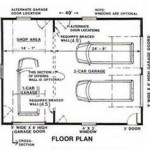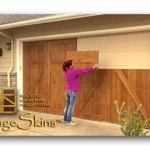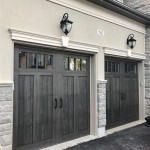Can You Paint A Metal Garage Door To Look Like Wood? A Comprehensive Guide
The aesthetic appeal of a wooden garage door is undeniable. Its warmth, natural grain, and inherent texture can significantly enhance a home's curb appeal. However, the practical considerations associated with wood, such as susceptibility to weather damage, insect infestation, and high maintenance requirements, often make it a less desirable option for many homeowners. Metal garage doors, on the other hand, offer durability, security, and lower maintenance. Fortunately, it is entirely possible to achieve the desired look of a wooden garage door by painting a metal one, offering the best of both worlds – the aesthetic of wood and the practicality of metal. This article provides a comprehensive guide on how to effectively paint a metal garage door to mimic the appearance of wood grain.
The process involves careful preparation, the selection of appropriate materials, and the application of a specific painting technique. The ultimate goal is to create a realistic wood grain effect that is both visually appealing and durable enough to withstand the elements. This requires patience, attention to detail, and a systematic approach. By following the steps outlined in this guide, homeowners can transform their metal garage doors into stunning faux wood replicas.
Key Point 1: Preparation - The Foundation for a Realistic Wood Grain Finish
Proper preparation is paramount to achieving a convincing and long-lasting faux wood finish on a metal garage door. This stage involves cleaning, sanding, and priming the door to create a suitable surface for the paint to adhere to. Neglecting these steps can result in peeling, chipping, and an overall unsatisfactory appearance.
First, the garage door must be thoroughly cleaned. Use a mixture of warm water and a mild detergent to remove any dirt, grime, grease, or mildew. A pressure washer can be employed for this purpose, but caution should be exercised to avoid damaging the door's surface. After washing, rinse the door thoroughly with clean water and allow it to dry completely. This is essential as any remaining moisture can interfere with the paint's adhesion.
Next, inspect the door for any signs of rust. If rust is present, it must be removed. Use a wire brush or sandpaper to scrub away the rust until the metal surface is clean and smooth. For more stubborn rust, a rust converter or chemical remover may be necessary. Follow the manufacturer's instructions carefully when using these products and ensure proper ventilation.
Once the door is clean and free of rust, the surface needs to be lightly sanded. This is done to create a "tooth" for the primer to grip onto. Use a fine-grit sandpaper (around 220-grit) and gently sand the entire surface of the door. The goal is not to remove the existing paint, but rather to roughen it up slightly. After sanding, wipe down the door with a tack cloth to remove any sanding dust. This is critical as any remaining dust can compromise the primer's adhesion and affect the final finish.
Finally, apply a high-quality metal primer to the garage door. Choose a primer that is specifically designed for use on metal surfaces and is compatible with the topcoat paint that will be used later. Apply the primer in thin, even coats, following the manufacturer's instructions. Allow the primer to dry completely before proceeding to the next step. The primer acts as a bonding agent, ensuring that the topcoat paint adheres properly to the metal surface and provides a uniform base for the faux wood grain effect.
Key Point 2: Selecting the Right Materials - Paints and Tools for a Convincing Wood Grain Effect
The choice of paints and tools significantly impacts the final appearance of the faux wood finish. Using the wrong materials can result in an unconvincing or unprofessional look. Therefore, careful consideration should be given to selecting the appropriate paints, brushes, and other necessary tools.
Two primary paint colors are required: a base coat color and a graining color. The base coat color should be a shade that closely resembles the undertones of the desired wood species. For example, for a lighter wood like birch or maple, a light tan or beige color would be appropriate. For a darker wood like walnut or mahogany, a medium brown or reddish-brown color would be suitable. The graining color should be a shade that complements the base coat color and provides sufficient contrast to create a realistic wood grain effect. Generally, a darker shade of brown than the base coat is used for the graining color.
Acrylic latex paints are generally recommended for painting metal garage doors due to their durability, weather resistance, and ease of application. They are also water-based, making them easy to clean up. Ensure that the paints are specifically formulated for exterior use, as these paints are designed to withstand the harsh conditions of outdoor environments. It is best to use paints from the same brand to ensure compatibility and consistent performance.
In addition to the paints, several specialized tools are required to create the wood grain effect. A graining tool, also known as a wood grain rocker or a faux wood grain tool, is essential. This tool is designed to create the characteristic wood grain pattern on the painted surface. It comes in various sizes and patterns, allowing for different wood grain effects. A high-quality paintbrush with soft bristles is also needed for applying the base coat and for blending the graining color. A sea sponge can also be used to create a more textured and natural wood grain effect, especially for mimicking the look of distressed wood.
Other essential tools include paint trays, rollers for applying the base coat, painter's tape for masking off areas, drop cloths to protect the surrounding area, and a clean rag for wiping away excess paint or correcting mistakes. Having all the necessary materials on hand before starting the project will ensure a smooth and efficient painting process.
Key Point 3: Applying the Faux Wood Grain Technique - Creating a Realistic Appearance
Applying the faux wood grain technique requires patience, practice, and a steady hand. The goal is to create a realistic and natural-looking wood grain pattern that is visually appealing and durable. This involves applying the base coat, creating the graining effect, and adding finishing touches to enhance the overall appearance.
First, apply the base coat evenly to the entire surface of the garage door. Use a roller for larger, flat areas and a brush for smaller details and edges. Apply two thin coats of the base coat paint, allowing each coat to dry completely before applying the next. This will ensure proper coverage and adhesion. Avoid applying thick coats of paint, as this can lead to runs, drips, and an uneven finish.
Once the base coat is completely dry, it is time to apply the graining color. There are several techniques that can be used to create the wood grain effect, but one of the most common and effective methods involves using a graining tool. Dip the graining tool into the graining color paint and wipe off the excess paint with a clean rag. Then, gently rock the tool across the surface of the door, applying even pressure to create the wood grain pattern. Overlap each pass slightly to avoid creating gaps or streaks.
Experiment with different angles and pressures to create a more varied and natural-looking wood grain effect. You can also use a sea sponge to dab on the graining color in certain areas to create a more textured and distressed appearance. If you make a mistake or are not satisfied with the result, simply wipe away the paint with a clean rag and try again. Practice on a scrap piece of metal or cardboard before applying the technique to the garage door to get a feel for the tool and the desired effect.
After applying the wood grain effect, allow the graining color to dry completely. Once dry, you can add finishing touches to enhance the overall appearance. This may include applying a clear coat of exterior-grade sealant to protect the paint from the elements and add a subtle sheen. You can also use a fine-tipped brush to add knots or other details to the wood grain pattern. Finally, carefully remove any painter's tape and inspect the door for any imperfections. Touch up any areas as needed.
By following these steps and paying close attention to detail, homeowners can successfully paint their metal garage doors to mimic the appearance of wood, adding beauty and value to their homes without the maintenance concerns of real wood.

Diy Garage Door Makeover Gel Stain To Look Like Wood House Home

How To Paint A Door Look Like Wood It S Easier Than You Think Average But Inspired

Create A Faux Wood Garage Door With Gel Stain Crazy Life Littles

Create A Faux Wood Garage Door With Gel Stain Crazy Life Littles

How To Paint A Door Look Like Wood 7 Shades Choose From

How To Make A Metal Door Look Like Wood With Zar Stain

Create A Faux Wood Garage Door With Gel Stain Crazy Life Littles

How To Paint A Door Look Like Wood 7 Shades Choose From

Have Your Garage Door Faux Finished To Simulate Wood Yes Most Of These Photos Are Standard Metal Paint Doors

Diy Garage Door Makeover With Gel Stain Fresh Mommy Blog
Related Posts








